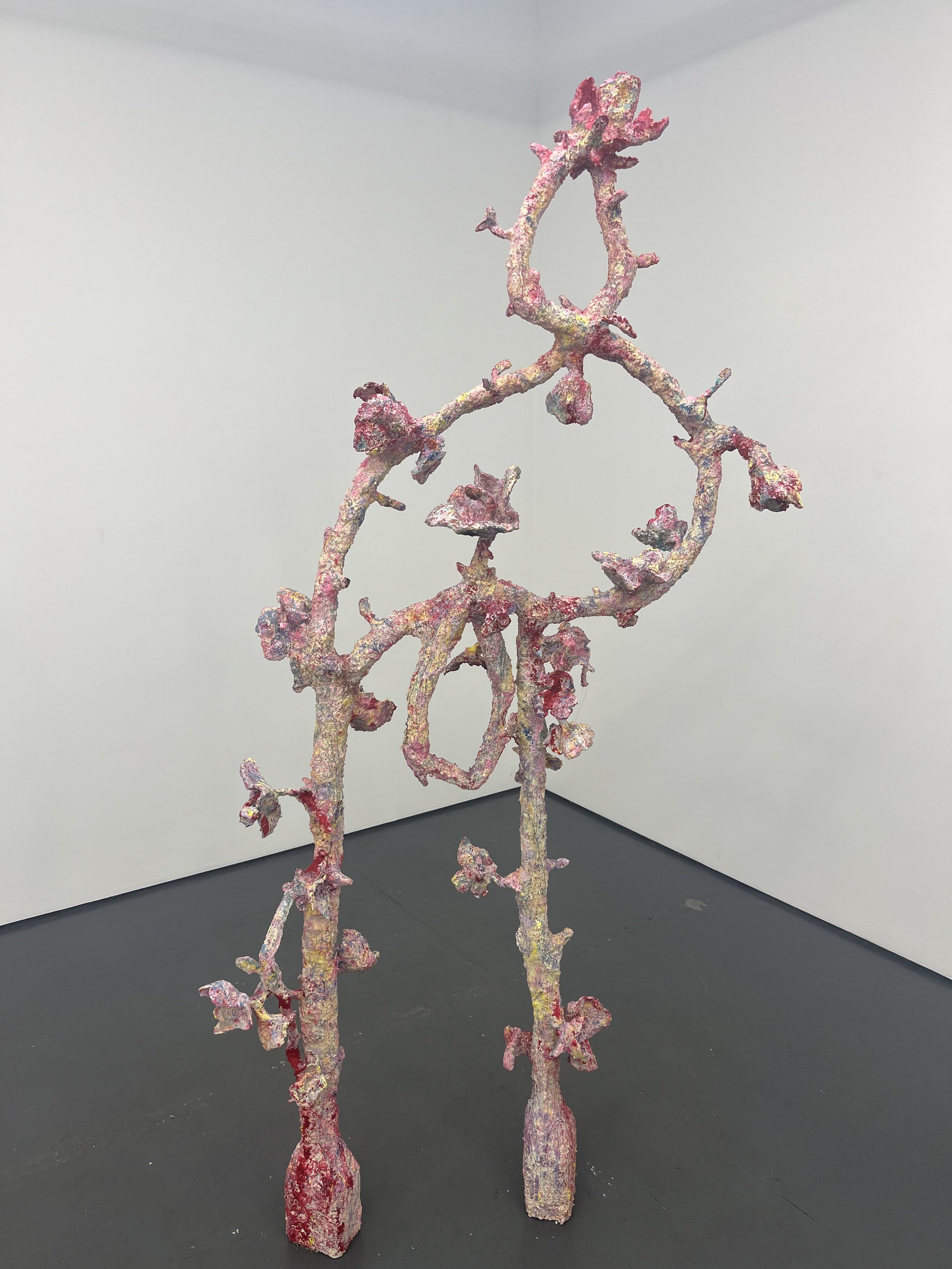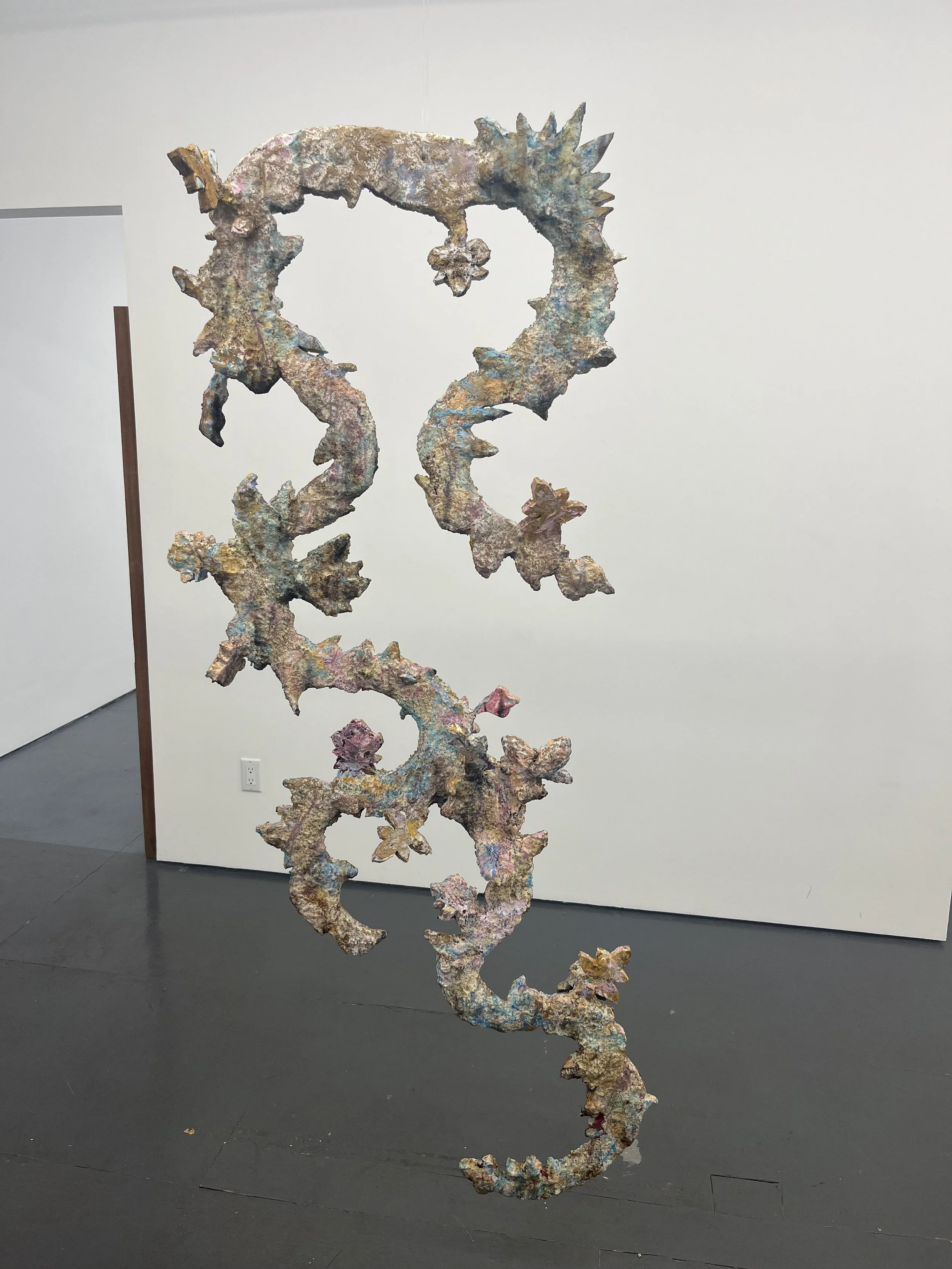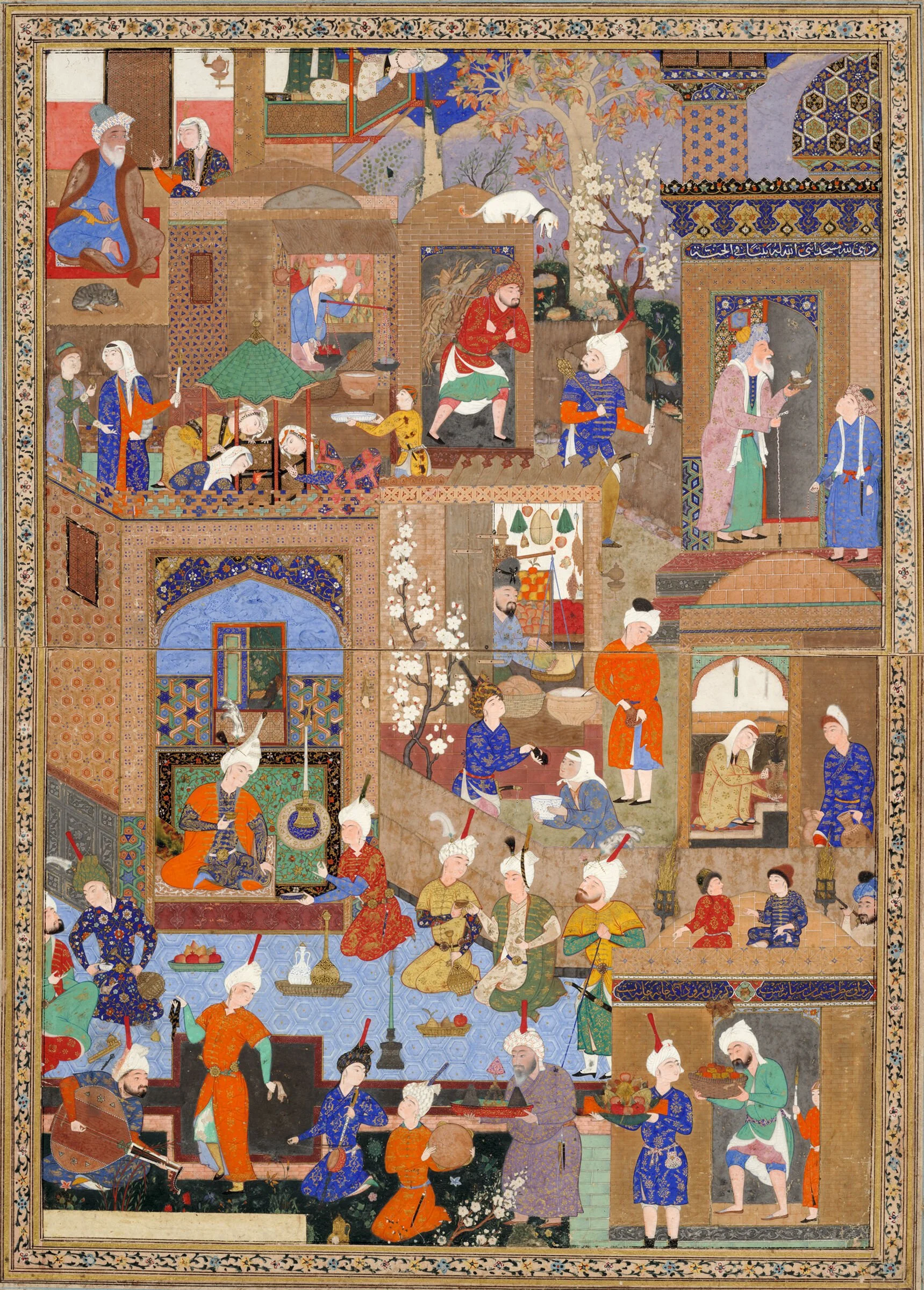Whispers, Glances, and Intimate Exchanges
Familiar Like Skin at Transmitter Gallery
“…when spring mates with sky behind the window,
fountains of green saplings will erupt—
saplings that bloom, beloved, my truest friend.
Let us believe in the dawn of the cold season…”
In the exhibition Familiar Like Skin at Transmitter Gallery, curators Sara Megdari and Lila Nazemian have placed the works and practices of two emerging New York-based artists, Anahita Bagheri and Bayan Kiwan, in an intimate dialogue. Through six new works, the exhibition suggests a pictorial and sculptural exchange about renewal, life cycles, patterns, decoration, interiority, and female agency. The Bushwick gallery’s smaller venue is ideally suited for a show of this nature. A throughline in Familiar Like Skin is the reciprocity of gazes and words among women of varying ages in Kiwan’s paintings and Bagheri’s anthropomorphic sculptures that evoke women’s bodies. A continuously evolving conversation seems to be taking place, rooted in the private painted realms and animated by the dynamic, floral-themed sculptures, all the while guiding guests from one work to the other.
Bayan Kiwan, Lesser Legible Love, 2023. Oil on canvas draped in tulle-like fabric, 44 x 35.8 in.
In Lesser Legible Love (2023), Kiwan has constructed a tightly cropped oil painting filled with successive layers or barriers to entry, situating two young women in the middle of the composition. While viewers are privy to their intimate exchange, they are firmly kept at a distance by one figure’s extended leg—demarcating the boundary between public and private domains. With their faces largely concealed by perforated leaves seemingly plucked from the potted Monstera in the background, one figure leans in to confide in the other. Their closed eyes serve to underscore a feeling of interiority or escape, further denying onlookers access to their shared realm of whispered words. Kiwan deploys several formal pictorial strategies to reinforce this sense of concealment and privacy: from angling the women’s limbs in order to form an interlocked singular unit to draping the oil painting with a white, gauzy tulle-like fabric with a diamond-shaped pinched pattern. The tilted blue cushion they sit on echoes the veiled grid of repeating squares. These rectilinear elements contrast with the more lyrical forms found in Bagheri’s papier-mâché sculptures, Twist, Falling and Stem, on Fire (both 2023).
Anahita Bagheri, Twist, Falling, 2023. Mixed media (papier-mâché and wood), 30 x 70 x 7 in.
Springing forth as two separate pillars at the base, Twist, Falling fuses towards the middle to form an interlaced, somewhat gnarled, and towering sculpture. Like Kiwan’s women locked in a surreptitious embrace, Bagheri’s winding vines also seem to conspire with one another, with petals and pistils appearing as personified mouths, tongues, and ears.
Anahita Bagheri, Four Petaled Bruised, 2023. Mixed media (papier-mâché and mesh), 22.8 x 16.5. x 9.8 in.
Nearby, Four Petaled Bruised (2023), with its folded and shriveled forms, resembles an enlarged orifice encrusted with flecks of pink, purple, yellow, and magenta—inviting guests to come closer. The shafts and limbs of Twist, Falling—composed of layers of moistened paper—elaborate these corporeal parallels and speak to the exhibition’s title. Along the hardened accretions of the vines are budding offshoots, suggestive of future paths and discourses. These signs of new life are balanced out by streaks of crimson oil pastels—perhaps evoking bloodshed and death—seen most clearly at the foot of the sculpture. As a whole, though, an overriding sense of resiliency is conveyed by the sculpture’s inspissated, textured layers and its botanical nodes full of promise.
Anahita Bagheri, Stem, on Fire, 2023. Mixed media (papier-mâché and wood), 30 x 70 x 7 in.
Stem, on Fire (2023), a sinuous, vine-like structure suspended from the ceiling that slightly rotates, continues the idea of budding, blossoming, and cyclicality. However, its surface appears more stone-like, and the colors—baby blue, pink, ochre, and dark blue—are more subdued. Where Bagheri employs bright red streaks in Twist, Falling to suggest violence and generational loss, she uses flames in her process here to suggest overcoming destruction or forging ahead in Stem, on Fire. Throughout the serpentine kinetic sculpture, she has singed edges, creating charred floral finials. The allusion to snakes and the shedding of skin is one more way the exhibition title resurfaces, and simultaneously references a number of mythological stories.
Example of islimi khataei ornamentation in Nighttime in a City, probably a folio from an illustrated manuscript, attributed to Mir Sayyid ‘ Ali (Persian, 16th century). Circa 1540, Safavid period. Opaque watercolor, gold, and silver on paper, 11 1⁄4 x 7 7/8 inches (28.6 x 20 cm). Harvard Art Museums/Arthur M. Sackler Museum, Gift of John Goelet, formerly in the collection of Louis J. Cartier. 1958.76.
In these sculptures, Bagheri draws upon islimi khataei ornamentation, which are decorative motifs readily found in Islamic architecture, on painted and lacquered pen boxes (qalamdan) from the Safavid dynasty (1501-1736), and along borders of folia from Persian illuminated manuscripts.[2] Given that these patterns were used on pen boxes and within books, and that her sculptures are largely built up through layers of paper, they inherently index the written and spoken word, the recording of history, and the articulation of ideas. Excised and magnified from their original historic contexts, Bagheri vivifies these mesmerizing arabesques, giving them a sense of plasticity or presence that gallery-goers ineluctably confront. At the same time, these monumentalized floral motifs still serve as framing devices. No longer structuring mechanisms for calligraphic texts or images within manuscripts—or along the lacquered veneer of pen boxes—the enlarged and enlivened tendrils act as frames within their new contemporary context.
Installation view of Familiar Like Skin, featuring Stem, on Fire (foreground) and What Window Could (background).
To my mind, the most stimulating and satisfying experiences from this two-person show come from the incidental, revelatory moments of walking behind Bagheri’s sculptures and catching Kiwan’s female figures framed within vignettes, creating focused vantage points. For instance, peering through the curvilinear armature of Stem, on Fire, one sees the decorative arrangement of colors and forms within What Window Could (2023). Similarly, through the thoracic opening of Twist, Falling, a spectator finds Kiwan’s central reclining figure in What Window Could perfectly cradled by Bagheri’s wending, islimi khataei-inspired vines. Between these three works is a triangulation of sorts—a palpable, inescapable center of gravity within the gallery where viewers become entangled in a thicket of sightlines, framing devices, and silently coursing conversations.
Installation view of Familiar Like Skin, featuring Twist, Falling (foreground) and What Window Could (background).
Kiwan’s largest and most compelling painting, What Window Could (2023), is a pastiche featuring prismatic vignettes of women in different domestic settings. In the foreground, a recumbent girl looks up intently while enjoying a popsicle and gestures with her left hand. Her trance-like countenance is consistent with the exhibition’s undergirding theme of suggestiveness and imagining alternative realities in the domestic sphere and the public realm. The oil painting’s title hints at this notion too; “could” implies a future possibility. In the middle background, two women share laughs and smiles across an opening in the draped white curtains, which recalls the diaphanous sheet shrouding Lesser Legible Love. The curators describe moments like this as “utopic camaraderie.” The left side of the canvas seems to represent a realm untethered from reality. While leaves fall at the feet of an extremely foreshortened set of knees and an abbreviated lower body, a hidden hand seems to offer cigarettes in a gesture of kindness. Kiwan directs our attention to a nurturing lap, which might be interpreted as a motherly site for love as well as received wisdom.
Bayan Kiwan, What Window Could, 2023. Oil on canvas, 51.9 x 82.6 inches.
Familiar Like Skin offers a generative artistic site for visitors to explore the exhibition’s attendant themes and intimate worlds of rebirth and reimagining. Blending private and public spaces, historic and contemporary modes of decorative painting, and women’s bodies with fecund botanical forms, the exhibition excels in prompting visitors to think about the spaces and activities that have been historically denied to women, and the ways in which women have collectively resisted those patriarchal limitations and foreclosures.
[1] Forugh Farrokhzad, “Let Us Believe in the Dawn of the Cold Season,” from Sin: Selected Poems of Forugh Farrokhzad, edited and translated by Sholeh Wolpé (Fayetteville: University of Arkansas Press, 2010).
[2] Islīmī, meaning ivy-and-spiral or vine-and-tendril patterning, and khatā’ī, meaning Chinese floral patterning, refers to a variety of geometric patterns based on intricate, stylized vegetal and floral motifs often interlaced with calligraphy. See Gülru Necipoğu and Mohammad al-Asah, The Topkapi Scroll—Geometry and Ornament in Islamic Architecture (Santa Monica: The Getty Center for the History of Art and the Humanities, 1995), pages 9, 112.










